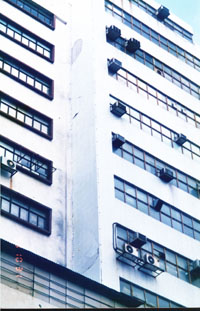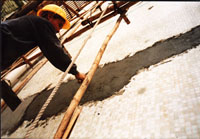![]()
 Debonding
plasters
Debonding
plasters
or spalling wall tiles is caused by many reasons, not simply the quality of renders that stick them on the substrate behind. The surface of the substrate, usually concrete in modern building, also affect the cohesiveness of renders in terms of roughness, water absorption, cleanness etc. As time goes by, carbonization takes effect on whatever the renders or the concrete, making the cementitious products vulnerable to be aging and losing its mechanical strength. As a result, fallen objects become fatal.
This chapter covers the rectification works for most common defects and the improvement of wall finishing for the old building that worth discussion rather than the new building under construction. Most debonding wall finishing is resulted from the water penetration in associated with steel bars erosion through the cracks or pinholes on the wall surface. Preparation of sound substrate and renders of good quality are indispensable before wall finishing to be applied.
There are infra-red scanning and hammer test method available to locate the defective areas. The former is more scientific for the purpose of legitimation and large area evaluation. The latter is more practical with area of accuracy to every one square feet. After the area of defects is ascertained, the repairs are classified into two main categories.
Preparation of Substrate
 Any rusty shall be steel-brushed away from the steel bars and protected by
anti-rusty coating. For good anchorage for the mortar, a groove shall be chiseled behind
the steel bars. In case there are cracks or honey comb concrete, a proper repairs shall be
done with epoxy injection for sake of maintaining structural strength. A layer of polymer
modified slurry as a primer is applied to achieve good bonding to the substrate. There is
choice for the concrete repairs mortar which are mainly polymer modified mortar or bagged
high strength mortar. For a large area of application, a supporting framework is required
to prevent settlement of the mortar, especially for the soffit of the structure.
Any rusty shall be steel-brushed away from the steel bars and protected by
anti-rusty coating. For good anchorage for the mortar, a groove shall be chiseled behind
the steel bars. In case there are cracks or honey comb concrete, a proper repairs shall be
done with epoxy injection for sake of maintaining structural strength. A layer of polymer
modified slurry as a primer is applied to achieve good bonding to the substrate. There is
choice for the concrete repairs mortar which are mainly polymer modified mortar or bagged
high strength mortar. For a large area of application, a supporting framework is required
to prevent settlement of the mortar, especially for the soffit of the structure.
Improvement of Wall Finishing
Apart from hacking away all wall finishing, we have to consider how to improve or maintain the integrity of the existing wall finishing. When completing patch repairs, protective and decorative coatings are applied to protect the renders or substrate from further attack by water borne element such as chlorides, sulphate and carbon dioxide. In case of mosaic wall tiles, a layer of tile filler is applied to fill up the gap of the tiles before applying primer. An epoxy based primer is recommended because of its excellent adhesion and waterproofing. After that, a wide range of decorative topcoats are available either solvent based or water based as you like.